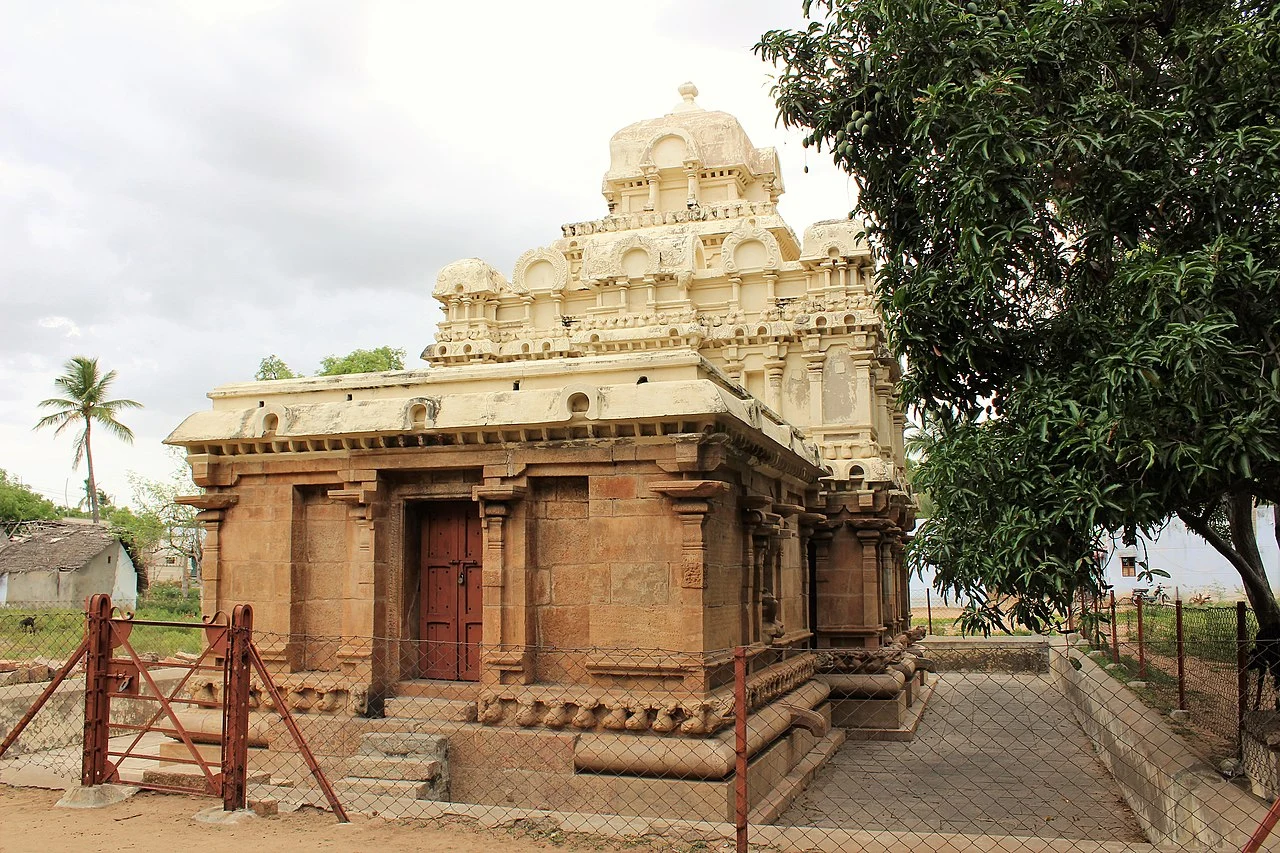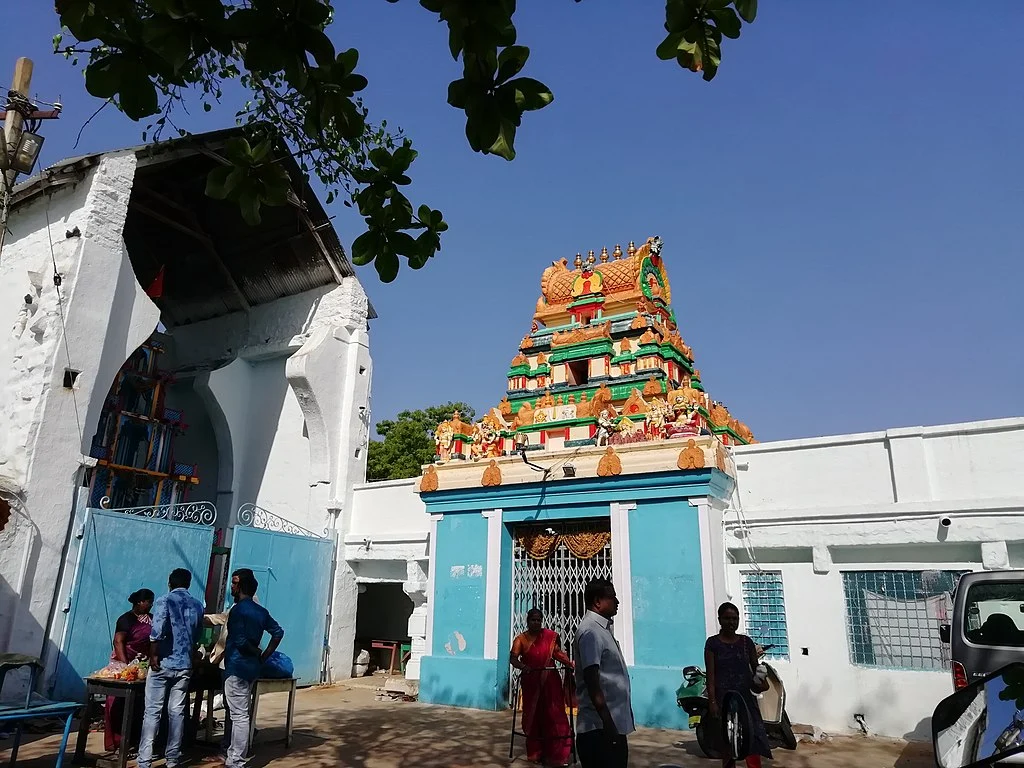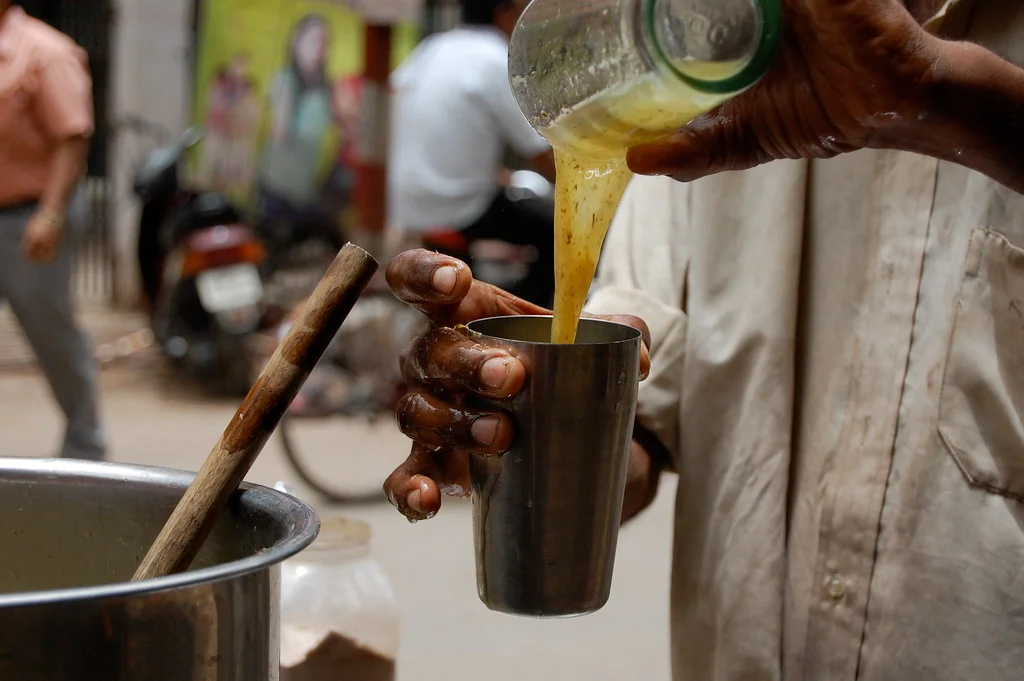I have always been captivated by period films, and for a movie enthusiast like me, “Ponniyin Selvan” was a fascinating experience. Directed by the renowned Mani Ratnam, this Indian Tamil-language epic action drama transported me back to a bygone era. The film brilliantly spotlighted the grandeur of one of India’s most illustrious kingdoms, reigniting a fascination with the Cholas. From the powerful kings and queens to the luxurious architecture and jewels, PS has rekindled my love affair with the Chola dynasty. It stirred a desire to journey back to their time, marvel at their architectural prowess, and soak in the aura of their era. Although time travel remains a fantasy, exploring the magnificent Chola dynasty temples they left behind is very much within reach.
By the 11th century, the Chola empire had expanded across vast regions of southern and western India and even influenced areas as far as the Maldives and Indonesia. The Cholas were one of India’s pioneering maritime superpowers, with naval victories and extraordinary architectural achievements that still awe us. To truly experience their grandeur, there’s no better place than the heartland of Tamil Nadu, where this medieval dynasty thrived. With a burning desire to witness these historical marvels firsthand, I booked a Savaari from Coimbatore and set out on an unforgettable road trip to trace the Chola dynasty architecture.
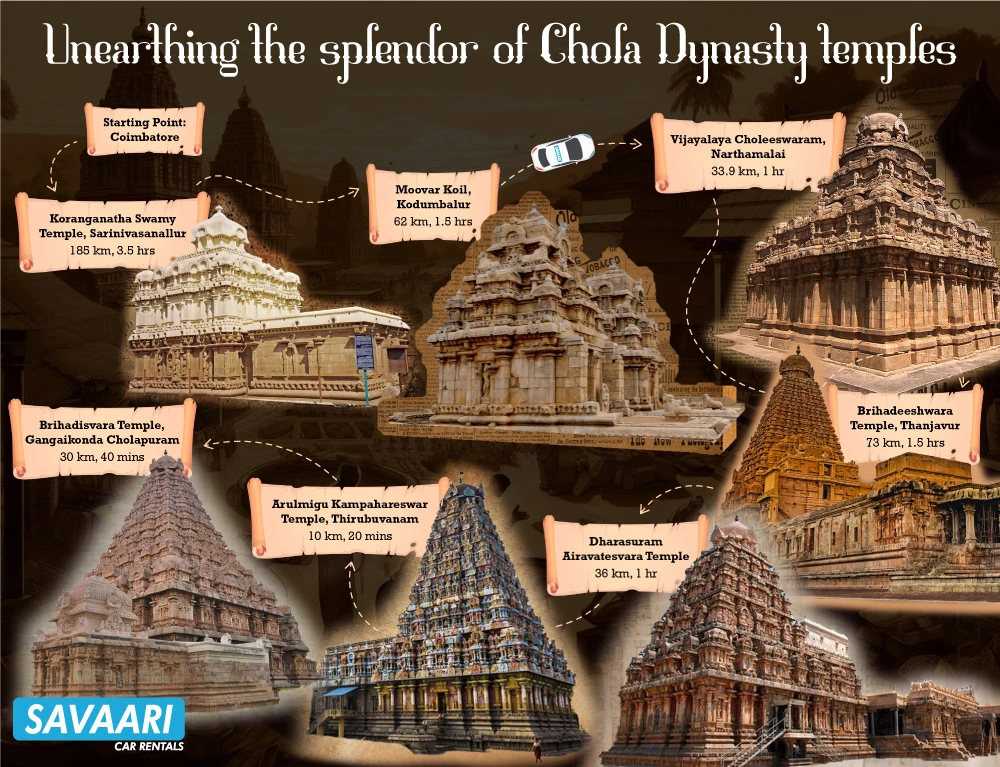
Unveiling the Chola Dynasty – A journey through history and legacy
While preparing for my journey, I delved deep into the history and legacy of the Chola dynasty. Though their names frequently appeared in our history textbooks, I never encountered such detailed accounts before. My research indicated that the Cholas are remembered as one of the longest-ruling dynasties in southern India. Their reign began in the 9th century when they defeated the Pallavas to rise to power. It stretched over five centuries until the 13th century. Interestingly, as early as the 2nd century, there was a Chola kingdom that flourished in the region now known as Andhra Pradesh.
During the early period of Chola’s rule, the famous Sangam literature emerged, marking a significant cultural milestone. Kantaman was a notable ruler of this era. The medieval period saw the Cholas reach the pinnacle of their power and development. Kings like Aditya I and Parantaka I played crucial roles during this time. Subsequently, Rajaraja Chola and his successor, Rajendra Chola, expanded the kingdom into the Tamil region. Later, Kulothunga Chola extended their dominance by conquering Kalinga. This era of magnificence continued until the early 13th century when the Pandyas began to rise.
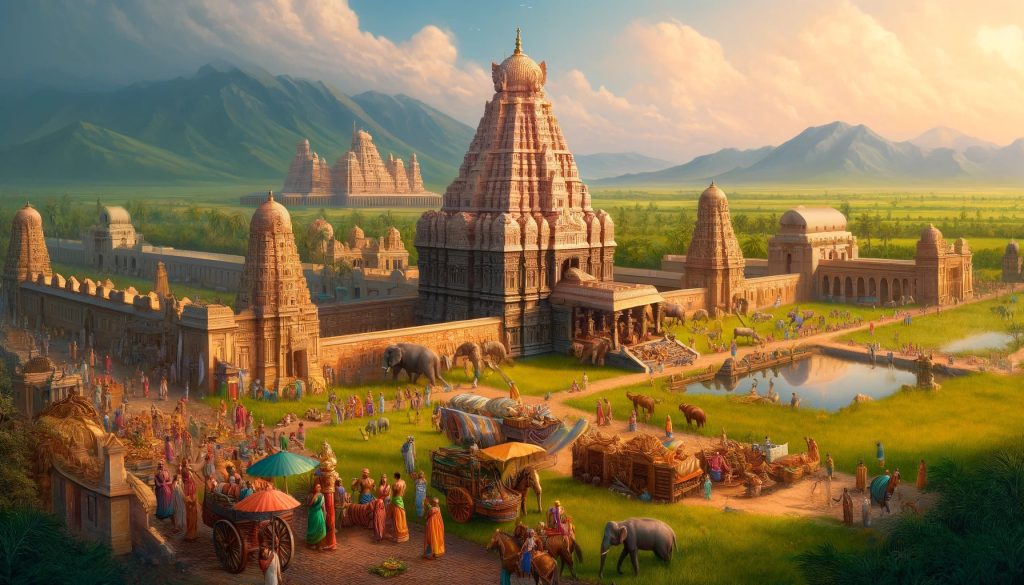
Under the Cholas, society and culture flourished. Temples became central to social and religious gatherings, serving as schools where Holy Scriptures and ancient Vedas were taught. The Chola period was marked by significant advancements in art, religion, and literature. Numerous Shiva Chola dynasty temples were constructed along the banks of the Kaveri river. It showcases the architectural and spiritual zenith of the Chola dynasty.
The splendour of Chola architecture
As I delved deeper into my research, I couldn’t help but wonder if the architecture depicted in the movie “Ponniyin Selvan” was historically accurate. Temples, which became central to social and religious gatherings, seemed like the perfect places to witness this firsthand. To satisfy my curiosity, I decided to explore these architectural marvels firsthand. What I discovered was truly fascinating.
Historically, the Chola kings were prolific builders, erecting numerous temples throughout their vast kingdom. Many early Chola dynasty temples are located in what is now the Pudukottai region. Initially, these temples were constructed using bricks, but as their architectural prowess evolved, they began to be built with stone.
The Cholas made remarkable advancements in construction techniques. They developed efficient systems for quarrying and transporting massive stone blocks. This technological progress enabled the creation of grand, intricately designed temples that have stood the test of time. Chola dynasty temples are renowned for their towering vimanas (temple towers), elaborate sculptures, and detailed frescoes. These structures were not just places of worship but also centres of social and cultural life. Each temple served as a hub for community gatherings, education, and artistic expression.
The architectural style of the Cholas is characterized by its precision, symmetry, and grandeur. The Brihadeeswarar Temple in Thanjavur, built by Rajaraja Chola I, is a prime example of their architectural genius. Its towering spire, intricate carvings, and imposing structure reflect the zenith of Chola craftsmanship. Through my journey, I aimed to not only witness these magnificent structures but also to appreciate the historical and cultural context that gave rise to such architectural wonders.
On the road – The majestic Chola dynasty temple trail
Embarking on a road trip from Coimbatore to the iconic Chola dynasty temples promised to be a journey filled with rich history and scenic beauty. My chauffeur, Ravi, provided a wealth of knowledge about the region and its treasures. He informed me that typically, only three temples are regarded as the “Great Living Chola Temples”: the Gangaikonda Cholapuram, the Brihadeesvara Temple at Thanjavur, and the Airavatesvara Temple at Darasuram. These were initially the only temples on my itinerary.
However, Ravi shared an exciting revelation: there are numerous other temples associated with the Cholas that are equally significant. This unexpected information added an element of surprise and anticipation to our journey.
As we left Coimbatore, the landscape began to transform. The urban sprawl gave way to lush green fields and rustic villages, each scene more picturesque than the last. The winding roads, flanked by coconut groves and quaint settlements, provided a serene backdrop for our trip. Our first stop was for breakfast at Nandhan Kitchen, where Ravi recommended the Thate Idli with filter coffee. The soft, fluffy idlis paired perfectly with the aromatic filter coffee, making it a delightful start to our day. With our hunger satiated, we were back on the road, eagerly watching the changing scenery.
As we drove on, the vistas shifted from tranquil villages to bustling towns, each with its own charm and character. Our destination, the first of the Great Living Chola Temples, loomed closer with each passing mile. The anticipation built as we approached our first stop, the grandeur of the Chola architectural legacy ready to be unveiled before our eyes.
Koranganatha Swamy Temple, Sarinivasanallur
Distance from Coimbatore: 185 km
Time taken: 3 hr 30 min
Our first destination on the Chola temple trail was the Koranganatha Swamy Temple. It is dedicated to Lord Vishnu, located in Srinivasanallur Town in the Trichy District of Tamil Nadu. As soon as I laid eyes on the temple, I was awestruck by its beauty. The intricate carvings and the serene surroundings on the banks of the river Cauvery added to its allure.
Upon arrival, I was fortunate to find a knowledgeable temple guide who provided a wealth of information about the temple’s history and architectural significance. Constructed by the Medieval Cholas, the temple is dedicated to the god Ranganatha and is protected by the Archaeological Survey of India (ASI). The region is referred to as Mahendra Mangalam in inscriptions, indicating its historical significance.
Unique architectural features
The Koranganatha Swamy Temple is a prototype of early South Indian architecture, notable for its compact structure without surrounding walls. The presiding deity here is Sri Koranganatha Swamy, depicted in the divine form of Lord Vishnu. Although it is no longer a living temple, its stunning architecture is well-preserved under the care of the ASI.
The temple’s vimana (tower) is particularly striking, featuring a unique two-tier structure with a smaller central third tier crowned by a square dome and a finial. The walls are adorned with inscriptions dating back to the reign of Parantaka Chola I (935–950 CE) and earlier, showcasing the continuity of worship and endowments over several centuries.
The historical significance of Koranganatha Swamy Temple
Research showed me the fascinating history of the Chola dynasty temple. It was built by Parantaka I, known for his conquests, including Madurai and Ilam (Ceylon). The region, referred to as Mahendra Mangalam, might have been named after a Pallava king, possibly Mahendravarman I. He ruled over Trichy during his reign. Despite this, there are no direct references to this region in Pallava inscriptions.
Legends and stories
The temple’s guide told us that a popular story suggests that the temple was built by a sanyasi (ascetic) who abandoned it after spotting a monkey (korangu) on top, considering it a bad omen. However, the extensive inscriptions and records from the days of Aditya I to Kulottunga I (21st year, 1091 CE) refute this legend, attesting to the temple’s continuous worship and significance.
The Koranganatha Swamy Temple was a perfect first stop on our Chola temple trail. It set the tone for the journey, offering a glimpse into the Cholas’ architectural brilliance and rich cultural heritage. The serene ambience and the intricate artistry of the temple left a lasting impression.
Koranganatha Swamy Temple to Moovar Koil, Kodumbalur
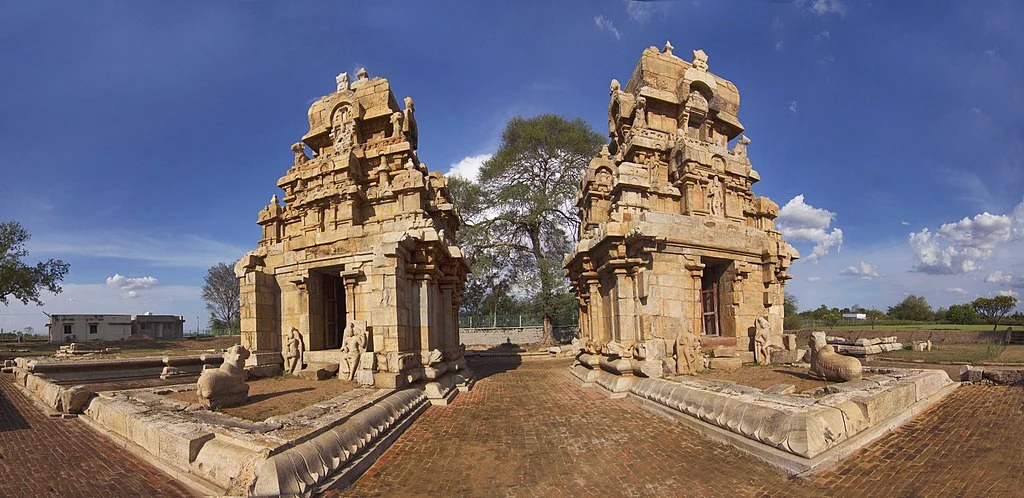
Distance: 62 km
Time taken: 1 hr 30 min
After visiting the Koranganatha Swamy Temple, Ravi informed me about our next stop: Moovar Koil in Kodumbalur, approximately 62 kilometers away. He mentioned that Kumbakonam Kodumbalur was once believed to be a temple city with a total of 108 temples. This intriguing fact heightened my eagerness to explore the site.
Upon arriving at Moovar Koil, I was immediately struck by the magnificence of the temple structures. The architecture appeared incredibly advanced for its time. This ancient complex of three Siva temples from the ninth century stands as a living testament to early and medieval Chola architecture. It is one of the oldest surviving temple structures from that era. Although the temple is not actively used for worship today and some parts are in ruins, restoration efforts by the Archaeological Survey of India are underway. Despite this, it remains a popular tourist destination, celebrated for its historical and architectural significance.
Historical context
Moovar Koil was built by Bhooti Vikrama Kesari of the Irukkuvel clan, an ally of the Cholas and a contemporary of Aditya Chola. Bhooti Vikrama Kesari is believed to be the son of a Chola princess named Anupama Devi and the Irukkuvel chieftain Sambarabriman. The name “Moovar Koil” (Three Temples) is derived from inscriptions at the nearby Muchukundeswarar temple, indicating that this place was once called Vikrama Kesareeswaram after the Irukkuvel chieftain.
Multiple interpretations
There are several interpretations of why this place is called Moovar Koil. One theory, based on inscriptions, suggests that Bhooti Vikrama Kesari built the three shrines for himself and his two wives, Kattrali Devi and Nangai Varguna Perumanar. Another interpretation is that the shrines were constructed to honor the three Tevaram saints – Appar, Sambandar, and Sundarar. A third, lesser-known view posits that the name refers to the three clans that ruled the region – the Cheras, Cholas, and Pandyas.
Architectural influences
The temple complex reflects some Pallava influences in its architecture, as the Mutharariyars, to which Bhooti Vikrama Kesari belonged, were initially vassals of the Pallavas. This blend of styles adds to the unique charm and historical importance of Moovar Koil.
Visiting Moovar Koil was a remarkable experience, offering a deeper understanding of Chola architecture and the rich history of the region. The detailed carvings, historical significance, and serene ambiance of the temple complex made it a standout stop on our Chola temple trail.
Moovar Koil to Vijayalaya Choleeswaram, Narthamalai
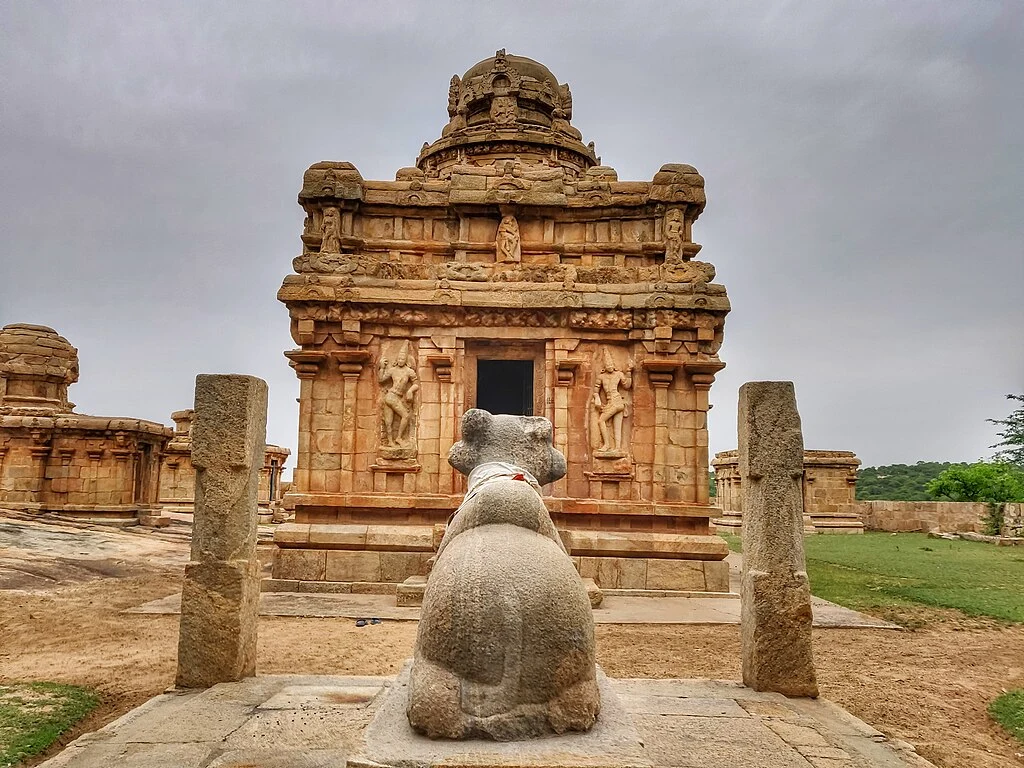
Distance: 33.9 km
Time taken: 51 min
Our next stop was 33 kilometres from Moovar Koil. Ravi drove us to a lesser-known but historically significant site: Vijayalaya Choleeswaram. As we approached, Ravi explained that this temple is one of the first mountain cave temples built by the Cholas and was renovated by the Chola king Vijayalaya Chola. Vijayalaya Chola, the ancestor of Raja Raja Chola, envisioned the grand Chola Empire and played a crucial role in its establishment.
Architectural and historical significance
Built approximately 1300 years ago, between the 7th and 9th centuries AD, the Vijayalaya Choleeswaram temple marks a significant period in South Indian history. During this era, the region was part of the Pallava kingdom and under the control of the Thanjavur Mutharaiyar kingdom. The first part of the Tamil novel “Ponniyin Selvan” references the Mutharaiyar lineage, notably when the Pazhuvoor fighters mock Vandhiya Devan’s horse. In the 9th century, Narthamalai came under Chola rule after Vijayalaya Chola defeated the Mutharaiyars.
Economic and cultural prosperity
It is believed that centuries ago, traders and businessmen, known as ‘Nagaratthaar,’ received the temples, ponds (Kulam), subsidies, and aids from the kings and efficiently managed them. Their efforts in preserving the place, implementing village development schemes, and collecting taxes earned them a stellar reputation. Consequently, Narthamalai became a prosperous trade capital. A notable business group called ‘Naanadhesatthu Ainnootruvar’ had its headquarters here, leading to the area being known as ‘Nagaratthaar Malai,’ which eventually evolved into ‘Narthamalai.’
Mythological connections
Narthamalai is surrounded by more than 80 hills, including Melamalai, Kottaimalai, Kadambarmalai, Paraiyarmalai, Uvakkanmalai, Aaluruttimalai, Bommaadimalai, Ponmalai, and Manmalai. According to legend, during the war between Rama and Ravana, Hanuman brought the Sanjeevi Mountain from the North to revive the fallen soldiers. As he transported the mountain, some fragments fell onto the ground, forming the Narthamalai hills. It is believed that these hills still contain rare herbs capable of curing many incurable diseases.
The Vijayalaya Choleeswaram temple is nestled among these hills, offering breathtaking views and a serene environment. Despite some parts being in ruins, restoration efforts by the Archaeological Survey of India are ongoing, preserving its historical and architectural value. This site, though not in active worship, attracts numerous visitors keen to explore its rich history and the legends that surround it.
Vijayalaya Choleeswaram to Brihadeeshwara Temple/Sri Raja Rajeshwaram, Thanjavur
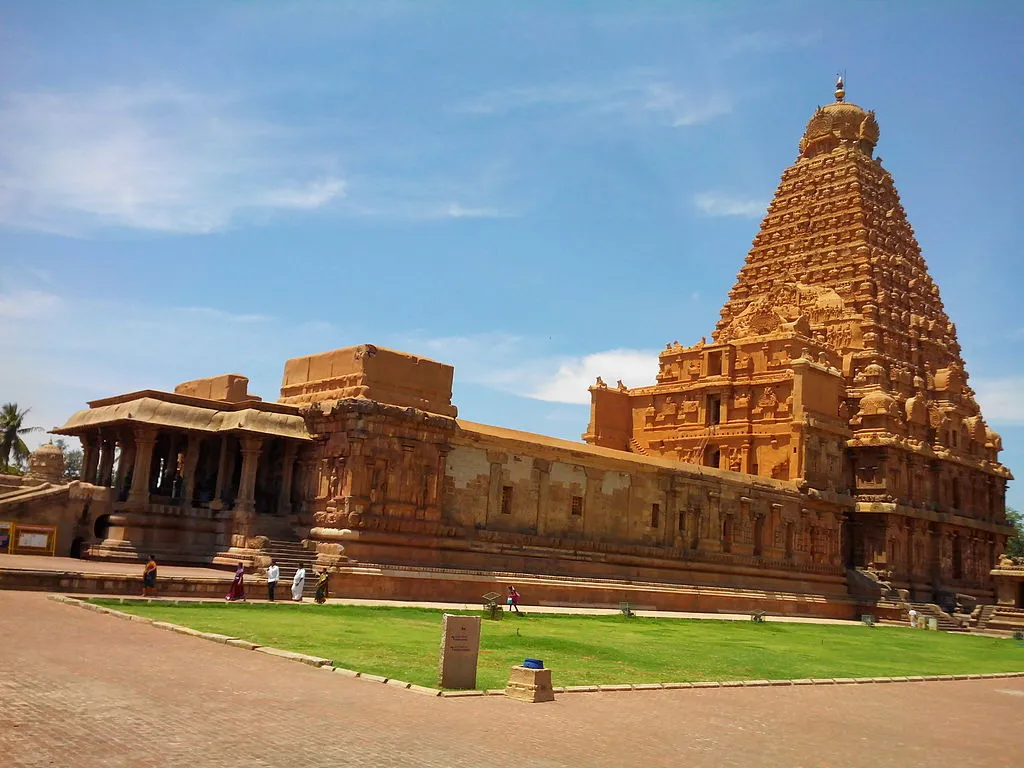
Distance: 73 km
Time taken: 1 hr 17 min
Our next destination was the magnificent Brihadeeshwara Temple, also known as Peruvudaiyar Kovil, located in Thanjavur. Ravi and I were both excited about this stop, as it is one of the largest temples in India and a prime example of Dravidian architecture from the Chola period. The anticipation built up as we neared the temple, which was completed in 1010 AD by Emperor Raja Raja Chola I and celebrated its 1000th anniversary in 2010. The temple is part of the UNESCO World Heritage Site known as the “Great Living Chola Temples,” alongside the Brihadeeswarar Temple at Gangaikonda Cholapuram and the Airavatesvara Temple.
Awe-inspiring architecture
As I walked through the entrance, I was immediately struck by the grandeur of the fortified walls, likely added in the 16th century. The towering vimanam, standing at 216 feet (66 meters), is the tallest in the world, and its apex, the Kumbam, is carved from a single rock weighing around 80 tons. Seeing it in person was a breathtaking experience.
The massive Nandi statue at the entrance, also carved from a single rock, measures about 16 feet (4.9 meters) long and 13 feet (4.0 meters) high. The entire temple, constructed from granite sourced from about 60 kilometres away, symbolises the Cholas’ engineering prowess and artistic vision.
Historical significance
The Brihadeeswarar Temple was founded by Arulmozhivarman, popularly known as Rajaraja Chola I, who laid its foundations around 1002 CE. It was one of the earliest grand projects by the Tamil Chola dynasty, featuring a symmetrical and axial geometry that governed its layout. The emergence of multifaceted columns with projecting square capitals signified the arrival of the distinctive Chola style, showcasing the empire’s artistic and architectural innovations.
Richly endowed by the sovereign, the sanctuary had a permanent staff of several hundred priests, 400 devadasi (sacred dancers), and 57 musicians, according to inscriptions and chronicles. The Brihadisvara’s income in gold, silver and precious stones during the Chola period has been precisely evaluated. These vast resources were efficiently managed and provided not only for the upkeep and improvement of the buildings (which was continued until the 17th century) but also for real investments to be made. The temple lent money, at rates which could sometimes reach 30%, to shipowners, village assemblies and craft guilds.
A monument to Chola power and artistry
This Chola dynasty temple is a prime example of the Dravidian style of architecture. It embodies the ideology of the Chola Empire and the Tamil civilization of Southern India. The temple complex includes intricate carvings, paintings, bronze castings, and sculptures that highlight the Cholas’ brilliant achievements. It is said that Rajaraja Chola I was inspired by the Pallava Rajasimha Temples in Kanchipuram. He dreamed of creating a monumental temple for Lord Shiva. The Brihadeeswarar Temple is unique in that it is the first fully granite temple. It was completed in just six years, from 1004 AD to 1010 AD.
Walking through the Brihadeeswarar Temple, I felt a profound connection to history. The sheer scale and intricate details of the temple left me in awe of the Chola dynasty’s capabilities. Standing in the shadows of the towering vimanam and the grand Nandi, I couldn’t help but marvel at the architectural brilliance and the cultural significance of this site.
As I was leaving the temple, I noticed several shopkeepers selling Thanjavur art. I highly recommend stopping by to purchase some of this artwork, as it feels like bringing a piece of history back home. You can learn all about Thanjavur art here and why it makes the perfect souvenir here.
Brihadeeshwara Temple to Dharasuram Airavatesvara Temple, Gurunathan Pillai Colony
Distance – 36 km
Time taken – 50 min
Our journey continued to the Airavatesvara Temple in Dharasuram, a part of the Gurunathan Pillai Colony. As Ravi navigated the drive from Thanjavur, I couldn’t help but reflect on the rich history and architectural marvels we had already witnessed. Upon arriving at the Airavatesvara Temple, I was immediately captivated by its serene ambiance and intricate beauty.
Architecture, sculptures, paintings, bronze casting – the temple reflects the rich cultural heritage of the Chola dynasty. The temple, dedicated to Lord Shiva, is named after ‘Airavat’, the majestic white elephant of Lord Indra. A part of the trio of ‘Great Chola Temples’ is also a part of the UNESCO World Heritage Sites.
The history of the temple
The Airavatesvara Temple’s history dates back to the Chola empire, constructed by King Rajaraja Chola II in the 12th century. Originally, the temple complex was much larger, featuring seven streets and courts, akin to the Srirangam temple. Today, only one court containing the main temple remains, with ruins of towers and other structures nearby hinting at its former grandeur.
The legend of Airavata
Among the many myths and legends associated with the Airavatesvara Temple, one of the most popular tells the story of how the temple got its name. According to this myth, Airavata, the divine elephant of Lord Indra, was cursed by a sage and lost its white colour. To seek redemption, Airavata prayed at this temple. Lord Shiva appeared before him, blessing him and restoring his original form. Consequently, the temple came to be known as the Airavatesvara Temple.
Destruction and restoration
Like many other Chola-era temples and cities, such as Gangaikonda Cholapuram, the Airavatesvara Temple has faced significant damage over time. The exact reasons for this destruction are unclear, but some historians, like Vasanthi, suggest that the Pandyas might have damaged the site after defeating the Cholas in the late 13th century as a form of retribution for earlier conflicts.
In 2004, the Airavatesvara Temple was recognized as a UNESCO World Heritage Site, joining other Great Living Chola Temples, including the Brihadeeswara Temple in Thanjavur and the Temple of Gangaikondacholisvaram in Gangaikonda Cholapuram.
Architectural brilliance of Airavatesvara Temple
The Airavatesvara Temple is a stunning example of Dravidian architecture, known for its towering gopurams (gateway towers), pillared halls, and intricate sculptures depicting Hindu deities and mythological figures. The temple’s design and carvings are a testament to the artistic brilliance of the Chola dynasty.
Outside the courtyard, located a short distance away, is a separate goddess (Amman) shrine built to honour Parvati, Shiva&rsquos consort. This shrine was the earliest of its kind in Chola times and was created by a successor to Rajaraja II. It signifyies a belated acknowledgement of the importance of women in society.
Vimana and Mandapa
One of the most striking features of the temple is its vimana, or temple tower, which majestically rises above the sanctum sanctorum. This towering structure is adorned with elaborate sculptures and intricate details, showcasing the exceptional skill and craftsmanship of the artisans. The vimana is surrounded by smaller shrines dedicated to various gods and goddesses, creating a harmonious and awe-inspiring architectural ensemble.
The Chola dynasty temple also features a mandapa, a special gathering hall, renowned for its tall columns adorned with carvings of animals and gods. The ceiling of the mandapa is equally impressive, with stunning paintings and sculptures that add to the temple’s grandeur. I was beyond mesmerised by the intricate designs and decorations, which reflected the rich cultural heritage of Tamil Nadu.
Yet another mind-blowing part of the temple is the musical steps. These 7 singing steps that lead to the altar are intricately carved and represent seven musical notes. What a fascinating work of art that dates back thousands of years!
Dharasuram Airavatesvara Temple to Arulmigu Kampahareswar Temple, Thirubuvanam
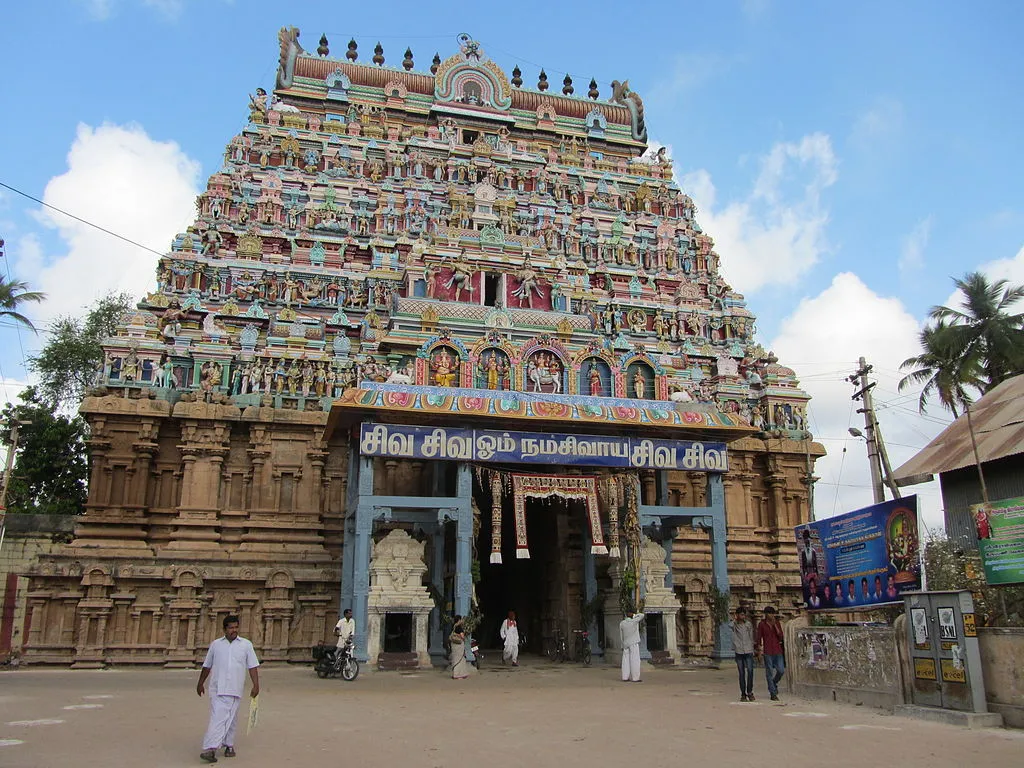
Distance: 10 km
Time taken: 20 min
The Kampaheswarar Temple, located at the end of the Mayiladuthurai-Kumbakonam road in the center of Tamil Nadu, is a haven of heavenly tranquility. This holy place is devoted to Lord Shiva, the most important Hindu deity, who is worshiped here under the name “Kampahareswarar.” The Kampaheswarar Temple is located in Thirubuvanam, a small village in Tamil Nadu’s Thanjavur region. For centuries, countless travelers have found comfort and devotion in this spiritual retreat. Its setting, amidst tranquil surroundings and natural landscapes, makes it the perfect site for both history buffs and spiritual searchers.
The Kampahareswarar legend
The name “Kampahareswarar” has a significant meaning. It comes from a powerful myth that explains why Lord Shiva is held in esteem in this distinctive shape. According to legends from long ago, a king was haunted at all times by a malignant Brahmarakshasa, a supernatural being. In search of assistance, the king resorted to Lord Shiva, the god of cosmic dance.
Lord Shiva came to the king’s rescue out of his limitless compassion. With his divine grace, he took the name “Kampahareswarar” and vanquished the quaking fear (Kampa) that had gripped the anxious king. The king’s life was changed by this brave deed, which also brought about a sense of security.
A Chola-era architectural marvel
The Kampaheswarar Temple is a monument of the Chola dynasty temples’ genius for architecture. One of the important Chola kings, Kulothunga Chola III, had it built during his rule. This temple is regarded as the crown jewel of a quartet of masterpieces created during the Medieval Chola era, a time known for its significant contributions to architecture and culture.
The architecture of the temple combines elaborate carvings, decorative pillars, and imposing gopurams (towering entrances). It displays the extraordinary skill of the craftspeople of the time, who dedicated their talents to building a location that not only functions as a religious sanctuary but also as a captivating piece of art that enthralls visitors.
You are immediately struck by the elaborate carvings, elegant pillars, and imposing gopurams as soon as you reach the temple grounds. Each stone and sculpture in the temple tells a tale of devotion and loyalty to the Chola dynasty. It serves as a living museum of Chola-era craftsmanship. The Kampaheswarar Temple’s spiritual essence is unlike anything else. The temple also houses an idol of Kampaheswari (Durga), who adds to the spiritual aura of the place with her grace and strength.
Arulmigu Kampahareswar Temple to Brihadisvara Temple, Gangaikonda Cholapuram
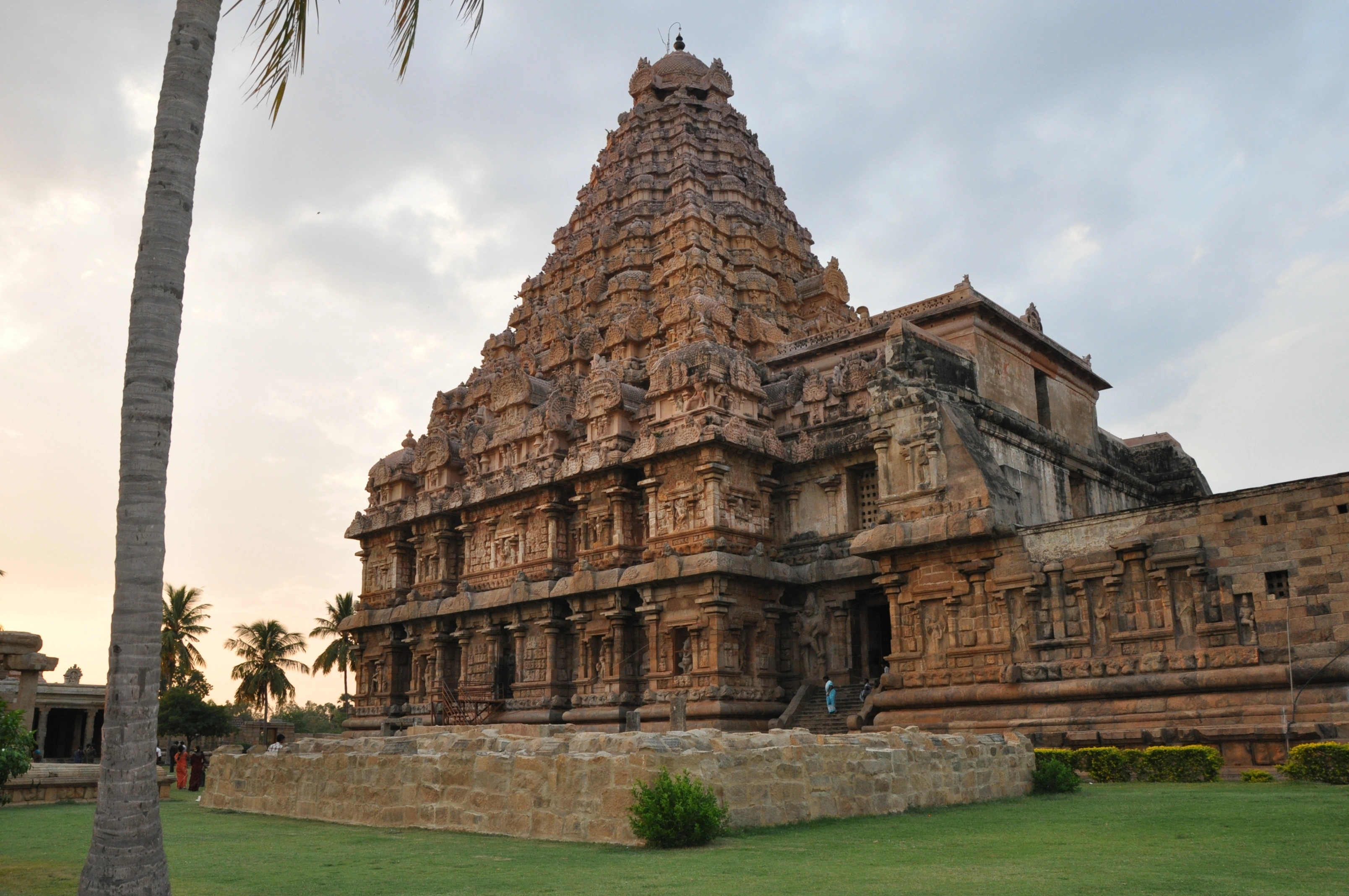
Distance: 30 km
Time taken: 41 min
I’ve always associated Thanjavur with Tanjore art, but the city is much more than that. Thanjavur, a beautiful city in Tamil Nadu, is a treasure trove of art, culture, and architecture. Serving as the capital during the 250-year rule of the Chola dynasty, Thanjavur offers endless opportunities for exploration and learning. Among its highlights is the Gangaikonda Cholapuram Temple, a stunning example of Chola dynasty temples’ architectural brilliance.
When I first entered the Gangaikonda Cholapuram Temple, I was struck by how it serves as a living history of the Cholas from the period of Rajendra-I. The temple is a magnificent gallery of Chola dynasty temples art and architecture. According to the temple guide, sculptures brought from Andhra, Karnataka, and Bengal as war trophies are also preserved in the temple and nearby villages. The most exquisite sculptures in the temple include Chandesura Anugraha Murthy and Sarasvathy.
History of Gangaikonda Cholapuram Temple
The Gangaikonda Cholapuram Temple was built in the 11th century by Rajendra Chola, the son and successor of Rajaraja Chola. Rajendra Chola, known for his military conquests and administrative prowess, decided to build a grander temple than the Brihadeeswara Temple constructed by his father. This Chola dynasty temples’ construction began after Rajendra Chola brought water from the River Ganges in a golden pot to consecrate the Cholaganga reservoir, earning him the title ‘Gangaikondan’ (the one who brought the Ganga). The temple, constructed between 1020 and 1029 AD, took nine years to complete and stands as a testament to the Chola dynasty’s architectural and artistic skills.
Architectural brilliance of Gangaikonda Cholapuram Temple
The Gangaikonda Cholapuram Temple is renowned for its grand scale and intricate design. It houses the largest Shiva lingam in South India, with the sanctum sanctorum built to accommodate the four-meter-high lingam. The sanctum is encircled by two walls, providing privacy for the royal family during prayers. The main entrance is adorned with beautiful images of Goddess Saraswati. The influence of Chalukya architecture is evident in the temple’s design, particularly in the icons of ‘Suryapita’ (Sun worship) and the ‘Navagrahs’ (nine planets).
Vimana and carvings
The temple features a nine-storey vimana (tower) that rises to a height of 185 feet, showcasing incredible craftsmanship and artistry. The structure is similar to that of the Brihadeeswara Temple, with the temple’s height measuring 54.86 meters. The rich carvings throughout the temple are unique to Chola dynasty temples’ artistry. It features intricate details on the vimana and other parts of the temple, inspired by North Indian temples.
The walls and ceilings of the temple are adorned with outstanding sculptures. It includes Ganesha, dancing Nataraja, Goddess Saraswati, Shiv-Parvati, and Ardhanarishvara. These sculptures reflect the Cholas’ artistic taste and creative genius, with every detail meticulously crafted on granite stones.
The preservation of the Chola dynasty temples’
Each of these Chola dynasty temples is a marvel to witness. It showcases the evolution of Dravidian architecture from the Chola period to the Maratha period. Remarkably well-preserved since their inscription as World Heritage sites, these monuments face no major threats. The Archaeological Survey of India diligently maintains and monitors them.
The tradition of temple worship and rituals, rooted in ancient Agamic texts and practised for over a thousand years, continues daily, weekly, and annually, seamlessly blending into the lives of the local people. Each temple offers a unique experience, and beyond its sacred grounds, the beauty of Thanjavur and its surrounding areas awaits exploration. Thanjavur is the ideal destination to immerse yourself in the grandeur of the Chola dynasty, making this Thanjavur travel guide a must-have for your journey.
Other Chola marvels across India
The Chola dynasty’s architectural and cultural influence is predominantly showcased through their magnificent Chola dynasty temples in Tamil Nadu. However, their legacy extends beyond Tamil Nadu, reaching into Karnataka as well. Here, we explore some of the remarkable Chola dynasty temples both within Tamil Nadu and in Bangalore, Karnataka.
In Tamil Nadu
Tiruvalithayam Tiruvallesvarar Temple
Located in Padi, Chennai, this temple is dedicated to Shiva, represented by the lingam, and Parvati as Jagadambiga. The temple, associated with the sage Bharadwaja, features inscriptions and structures. It dates back to the Chola dynasty in the 11th century. Book a Savaari in Chennai to explore this spiritual Chola dynasty temple.
Aiyarappar Temple
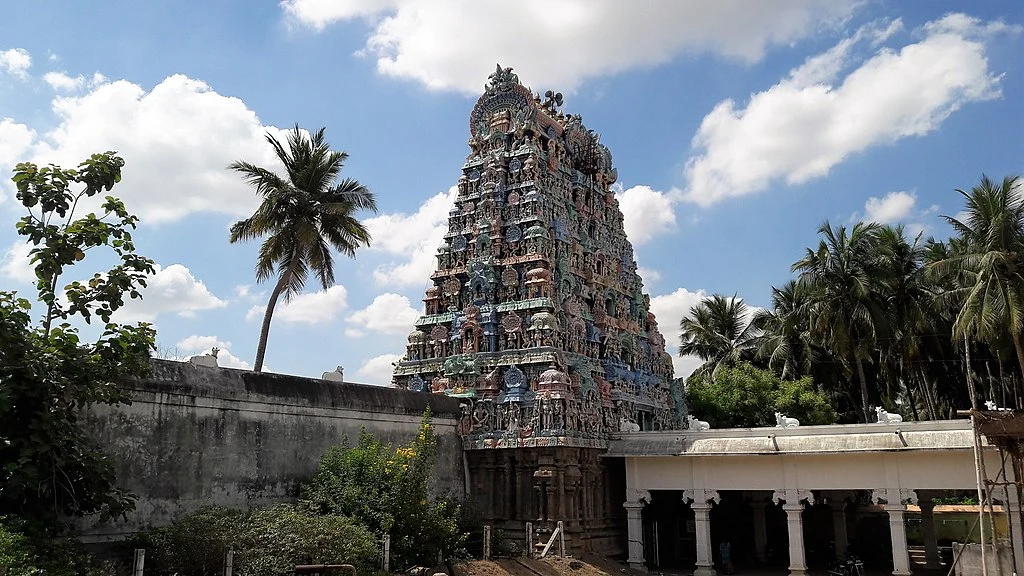
Situated in Tiruvaiyaru, this temple venerates Shiva as Aiyarappar and Parvati as Dharmasamvardhini. Known as Dakshina Kailasham, it is the birthplace of Nandi, Shiva’s mount. It features inscriptions from various dynasties, including the Cholas.
Vaitheeswaran Koil Temple
This temple in Tamil Nadu is dedicated to Shiva as Vaidyanathar, the “God of Healing.” Renowned for its association with the planet Mars, it has inscriptions from the reign of Kulothunga Chola I and contributions from several other dynasties.
In Karnataka
Domlur Chokkanathaswamy Temple, Domlur, Bangalore
Despite its renovated façade, the sanctum and ardha mandapas date back to the Chola Empire (1004 AD-1116 AD), reflecting the Cholas’ architectural prowess in southern Karnataka.
Halasuru Someshwara Temple, Halasuru
The oldest temple in Bangalore, dedicated to Shiva, dates back to the 12th and 13th centuries. It features intricate sculptures and has undergone significant modifications during the Vijayanagar Empire. Book a taxi in Bangalore to explore the Halasuru Someshwara Temple and other Chola dynasty temples.
Eshwara Temple, Kengeri
This temple, dedicated to Shiva, originates from the period of Chola king Rajendra Chola (1050 AD). It is a significant example of Chola architecture in Bangalore.
Sri Madduramma Temple, Huskur
Dedicated to Goddess Madduramma, this 11th-century temple in Huskur, Bangalore showcases the Chola period’s architectural style. Known for its grand annual festival and unique chariot procession, it is a vital cultural and religious site.
Why embark on a Chola temple trail with Savaari
As my journey up the Coromandel Coast came to an end, my admiration for the Cholas, their master builders, and their exquisite stone Chola dynasty temples only grew. The experience felt like stepping into the set of “Ponniyin Selvan,” but seeing these historical marvels in person was far more profound. The Cholas’ lasting impact on Tamil Nadu is vividly displayed through their architectural achievements.
My journey was truly unique, thanks to my Savaari chauffeur, Ravi, who was like a walking encyclopedia. Not only did he provide an in-depth history of the Chola dynasty temples, of which he was very proud, but he also helped me discover the best local food and immerse myself in the region’s culture.
I highly recommend embarking on a Chola dynasty temples trail with Savaari. By booking through the Savaari car rental app, your journey will be seamless. Additionally, you’ll have the opportunity to explore several offbeat temples linked to the Cholas and their illustrious dynasty.
Last Updated on June 3, 2024 by blogadmin



